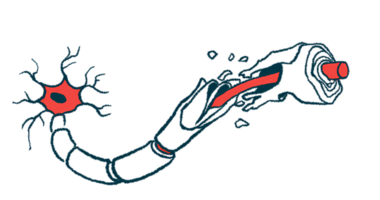ECTRIMS 2023: Vidofludimus calcium lowers RRMS nerve damage
Previous data showed therapy reduced rates of relapses, disability progression

Six months of treatment with the experimental oral therapy vidofludimus calcium (IMU-838) led to significant reductions in a marker of nerve damage among people with relapsing-remitting multiple sclerosis (RRMS), according to a new analysis of data from a Phase 2 clinical trial.
Previous data indicated the therapy significantly reduced lesions and resulted in low rates of relapses and disability progression.
Robert J. Fox, MD, a neurologist at the Cleveland Clinic presented the findings at the joint meeting of the European Committee for Treatment and Research in Multiple Sclerosis (ECTRIMS) and the Americas Committee for Treatment and Research in Multiple Sclerosis (ACTRIMS), this week virtually and in Milan. The poster was titled “Reduction in Neurofilament Light Chain by Vidofludimus Calcium: The EMPHASIS Study.” The work was funded by Immunic Therapeutics, the therapy’s developer.
Vidofludimus calcium is designed to reduce the inflammation that drives multiple sclerosis (MS) by blocking the activity of an immune cell protein called dihydroorotate dehydrogenase (DHODH). The therapy may have nerve-protecting effects by activating a nerve protein called Nurr1, recent data has also suggested.
Effect of vidofludimus calcium on NfL
The Phase 2 trial EMPhASIS (NCT03846219) tested vidofludimus calcium against a placebo in 268 people with RRMS. The participants were randomly assigned to receive 10, 30, or 45 mg of vidofludimus calcium or a placebo by mouth once a day for 24 weeks, or about six months.
The two highest tested doses led to marked reductions in MS activity on MRI scans, with patients taking the therapy having at least 70% fewer lesions than those taking a placebo. The proportion of patients having confirmed disability progression over the trial’s six months was also about two times lower with vidofludimus calcium (1.6% vs. 3.7%).
Given the recent data that vidofludimus calcium may have nerve-protecting effects, researchers examined EMPhASIS data to see how it affected levels of neurofilament light chain (NfL), a well-established marker of nerve damage.
“The poster presents a new analysis of neurofilament light chain data of our Phase 2 EMPhASIS trial of vidofludimus calcium in relapsing-remitting multiple sclerosis in light of the drug’s recently found supplemental mechanism of Nurr1 activation, a known neuroprotective target,” Andreas Muehler, MD, Immunic’s chief medical officer, said in an email to Multiple Sclerosis News Today. “Neurofilaments are highly specific neuronal proteins that, during neuronal injury, release several peptides [small proteins] into cerebrospinal fluid and are eventually measurable in blood. Elevated blood concentrations of neurofilament light chain have been found to correlate with an increase in the number of relapses and MRI disease activity in MS patients.”
Among those given 30 or 45 mg of vidofludimus calcium, the average NfL levels decreased by 3% after six weeks and by 19% after six months. The average levels increased by 2.5% at six weeks and by 7% at six months for those given a placebo.
The researchers also analyzed data from patients who didn’t have any evidence of inflammatory MS activity — meaning no new or enlarging lesions and no relapses — during the trial to see if the medication prevented nerve cell damage by reducing inflammatory activity or by other mechanisms.
“The analysis defined a subpopulation of this trial where focal inflammation did not play a role during the double-blind study period,” Muehler said.
In this group, average NfL levels fell by 3% for those given vidofludimus calcium and by 9% for those on a placebo at six weeks. By six months, the average reduction in NfL levels was 18% with active treatment and 13.5% with a placebo.
What about that placebo effect?
In subsequent analyses, the researchers compared NfL levels from the sixth week of the study through its end to try to account for the fairly strong placebo effect seen in the first few weeks. In this analysis, NfL levels decreased by 16% for activity-free patients on treatment and 1% for those on a placebo. Similar results were observed in the overall population.
“In both the overall study population and among subjects with no MS activity during the study, [vidofludimus calcium] doses of 30 mg and 45 mg suggest a potential benefit in reducing NfL compared to placebo,” the scientists said.
“The persisting difference, very similar to the overall study population, in serum neurofilament light chain for vidofludimus calcium compared to placebo among patients with nonactive inflammation suggests that vidofludimus calcium may have a biologically relevant effect beyond its known focal anti-inflammatory properties,” Muehler said.
‘Unparalleled’
A recent analysis of long-term data from EMPhASIS showed vidofludimus calcium was generally well tolerated up to four years. According to Immunic, data so far suggest the treatment has an “unparalleled safety and tolerability profile.”
“The observation in our EMPhASIS trial that vidofludimus calcium shows a meaningful improvement in serum NfL even in a nonactive MS patient population is very encouraging, as it suggests that the drug may even be active in the absence of inflammation, further supporting a potential role in neuroprotection,” Daniel Vitt, PhD, chief executive officer and president of Immunic, said in a company press release. “We believe that these effects may be related to vidofludimus calcium’s potent Nurr1 activation.”
Immunic is sponsoring two identical Phase 3 studies called ENSURE-1 (NCT05134441) and ENSURE-2 (NCT05201638) to further verify the efficacy of vidofludimus calcium in people with relapsing types of MS, including RRMS and active secondary progressive MS (SPMS). Patients are being recruited at sites worldwide.
Immunic also is running a Phase 2 trial called CALLIPER (NCT05054140) to test vidofludimus calcium against a placebo in people with primary progressive MS or SPMS who haven’t had recent relapses. CALLIPER finished enrollment this summer and top-line data is expected in 2025.
Note: The Multiple Sclerosis News Today team is providing in-depth coverage of the 9th joint ECTRIMS-ACTRIMS meeting Oct. 11-13. Go here to see the latest stories from the conference.








